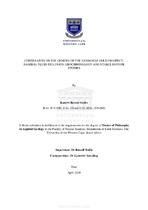| dc.description.abstract | The Sandamap gold prospect is a metaturbidite shear zone-hosted gold mineralization located in the Neoproterozoic Damara Orogen 30 km northwest of the town of Usakos in Namibia with an estimated gold content of 240 000 t at 3.6 g/t up to 40 m below surface. This research project was aimed at constraining the age, crustal level of formation, pressure-temperature conditions during formation, sources of the mineralizing fluids, and by implication, the metal sources of the Sandamap gold mineralization. Fluid inclusion, geochronological and isotopic studies were carried out on quartz veins hosting the ore. The presence of kaolinite, alunite and jarosite suggest post-hydrothermal weathering of sulfides. Various sources of data from this study, giving rise to depths of entrapment of 4 to 14 km, temperature range of entrapment of fluids of 187 – 594 °C, stable isotope data (δ13C and δ18O), δD values and a δD vs. δ18OH2O plot are all in favour of an orogenic gold deposit. Additionally, the dominant CO2-rich and CH4-rich fluids observed at Sandamap do not contradict this interpretation. The calculated depth of entrapment of mineralization covers the lower portion of the epizonal zone to the upper portion of the hypozonal zone of gold deposits. The Sandamap mineralization’s δD values of -35‰ to -49‰ fall within the range of most published data for typical orogenic gold deposits which varies from -20 to -80‰. Moreover, the calculated δ18Owater values of the ore-fluids (+6.6 to +11.3‰) of the higher temperature aqueous group from the Sandamap mineralization fall within the range observed in typical orogenic gold deposits found in Phanerozoic terrains (+7 to +13‰). The schist hosting the mineralized shear zone with a gold content of 0.05 ppm Au or its higher grade equivalent at depth, is a possible gold source candidate. Two mechanisms of deposition were possibly at play: (i) the cooling below 500 °C and possible sulfidation (resulting from fluid-rock interaction), lowered the solubility of pyrite causing S3- and Au(HS)S3- (possible main Au carriers) to breakdown resulting in decreased Au solubility and its subsequent deposition and (ii) the elevated amount of CO2 (e.g. trench 14 where CO2-rich fluid inclusions are dominant) led to a sharp decrease in the Au(HS)2- and Au(HS)S3- concentrations, causing decreased Au solubility and its subsequent deposition. The age of mineralization obtained from 40Ar/39Ar dating of the muscovite associated with the ore-hosting quartz veins is placed at 472 ± 3 Ma. The mineralization is younger than the shear zone, which acted as a conduit for ore-fluid migration and it has no age relationship with proximal plutonic bodies. The mineralization is younger than the foliated granite (FG), which exhibits a metamorphic fabric in the form of mineral segregation, but older than the non-foliated granite (GT) which hosts a mineralized xenolith. | en_US |

